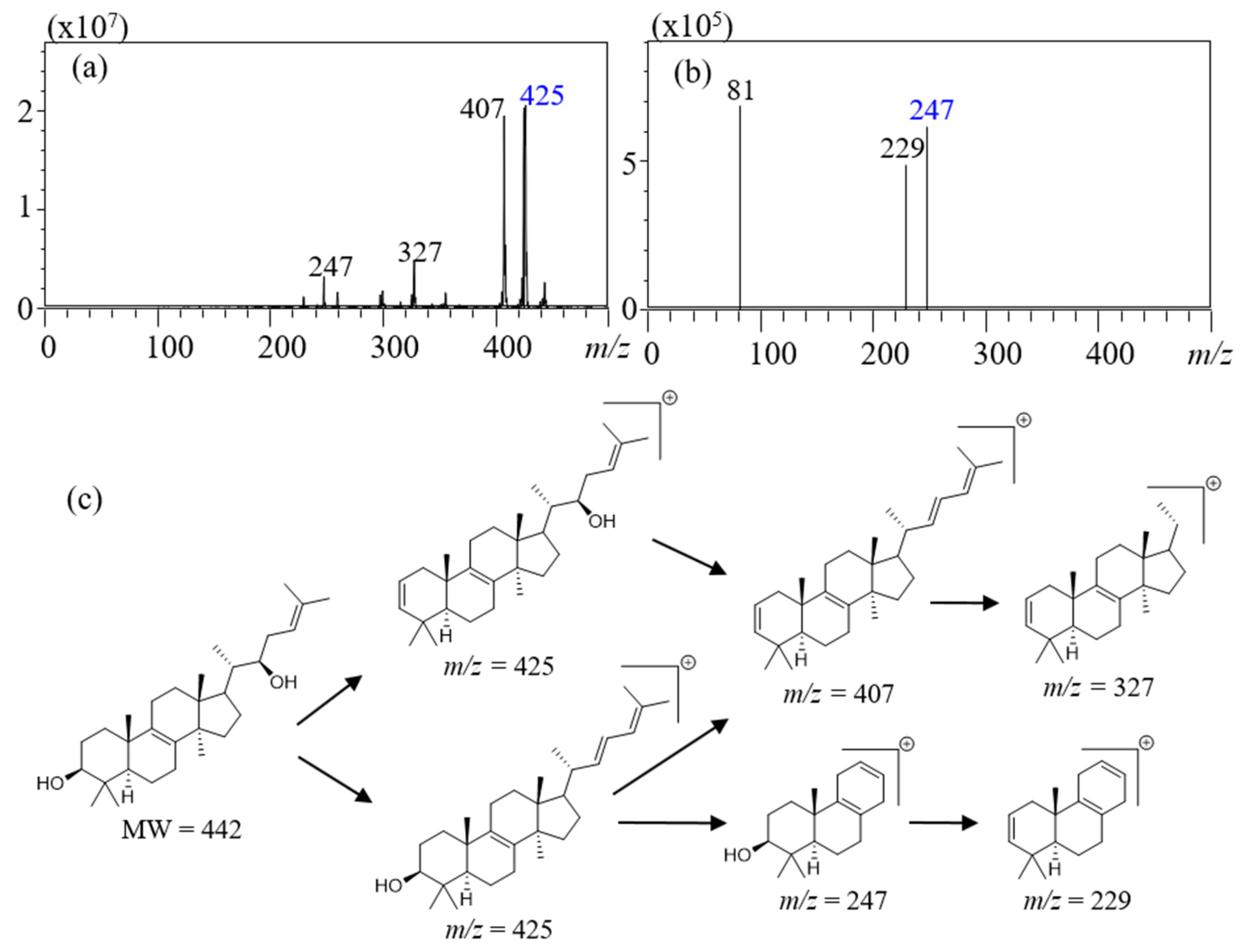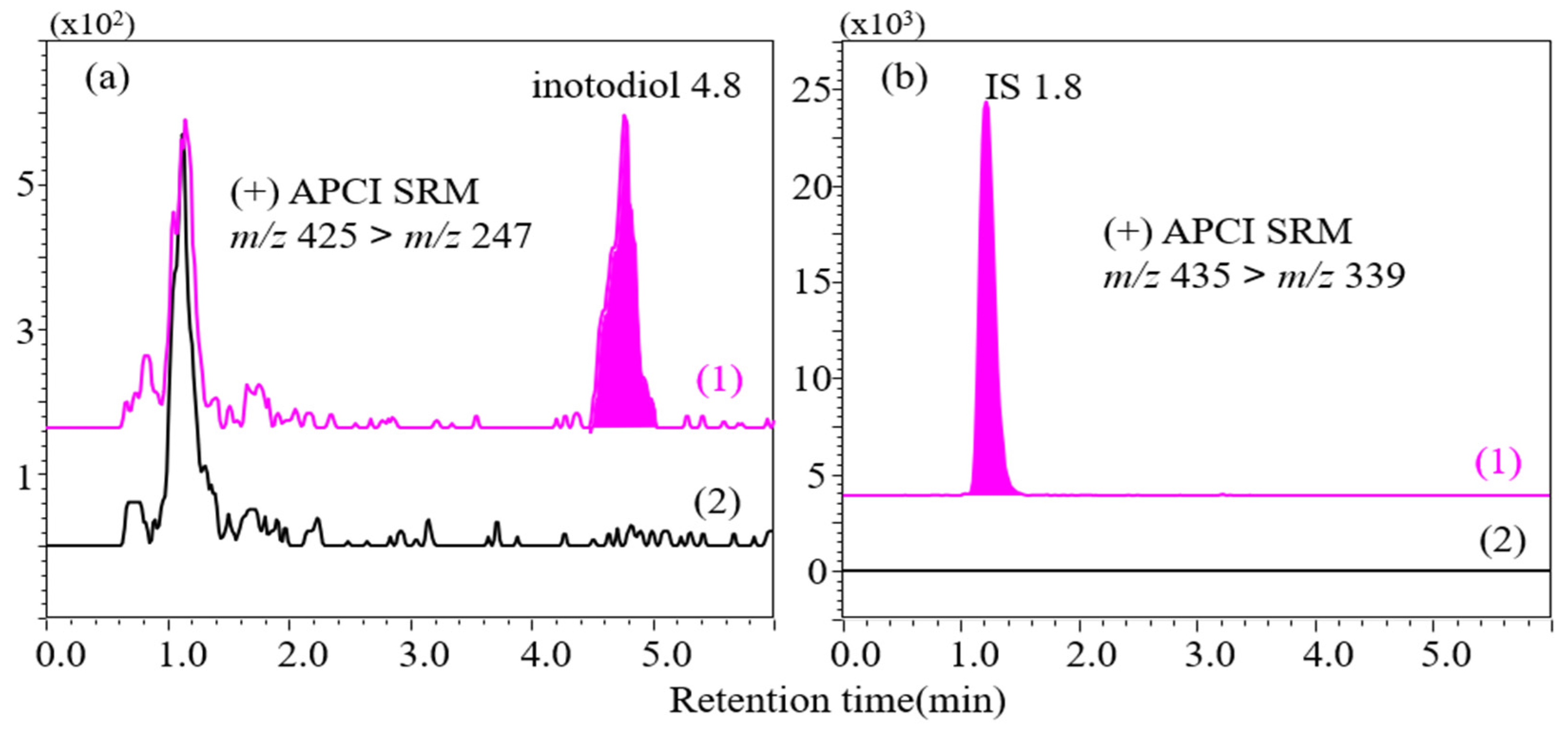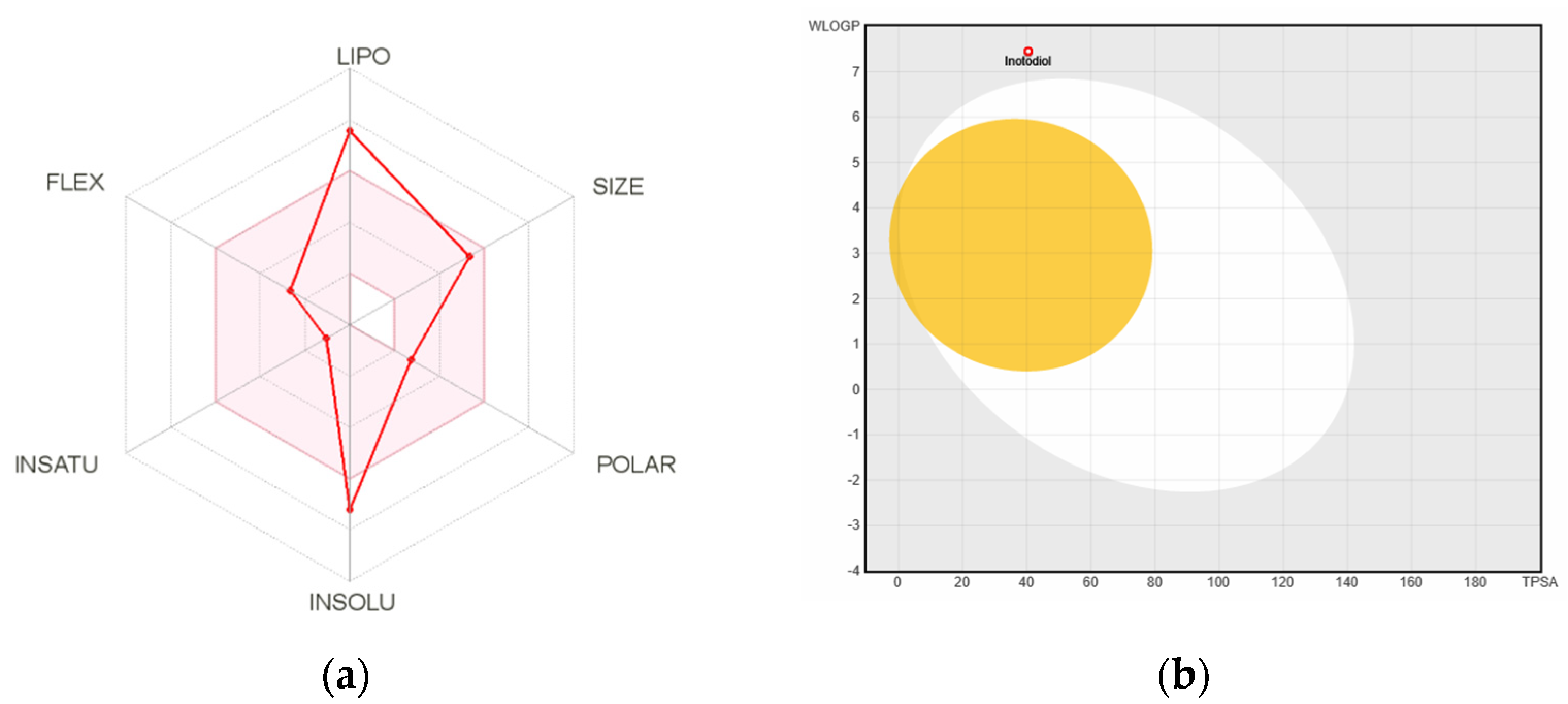A Novel Bioanalytical Method for Determination of Inotodiol Isolated from Inonotus Obliquus and Its Application to Pharmacokinetic Study
Abstract
:1. Introduction
2. Results and Discussion
2.1. Sample Preparation
2.2. Instrumental Analysis
2.3. Bioanalytical Method Validation
2.4. Application of Pharmacokinetic Study
2.5. Computational Prediction of Pharmacokinetics
3. Materials and Methods
3.1. Materials
3.2. Animals
3.3. Isolation and Purification of Inotodiol
3.4. Sample Preparation
3.5. Instrumental Conditions
3.6. Bioanalytical Method Validation
3.7. Pharmacokinetic Study
3.8. Computational Pharmacokinetic Study
4. Conclusions
Supplementary Materials
Author Contributions
Funding
Institutional Review Board Statement
Informed Consent Statement
Data Availability Statement
Acknowledgments
Conflicts of Interest
References
- Ma, L.; Chen, H.; Dong, P.; Lu, X. Anti-inflammatory and anticancer activities of extracts and compounds from the mushroom Inonotus obliquus. Food Chem. 2013, 139, 503–508. [Google Scholar] [CrossRef] [PubMed]
- Kahlos, K.; Kangas, L.; Hiltunen, R. Antitumor activity of triterpenes in Inonotus obliquus. Planta Med. 1986, 52, 495–554. [Google Scholar] [CrossRef] [PubMed]
- Zheng, W.; Miao, K.; Liu, Y.; Zhao, Y.; Zhang, M.; Pan, S.; Dai, Y. Chemical diversity of biologically active metabolites in the sclerotia of Inonotus obliquus and submerged culture strategies for up-regulating their production. Appl. Microbiol. Biotechnol. 2010, 87, 1237–1254. [Google Scholar] [CrossRef] [PubMed]
- Kim, Y.J. Chemical constituents from the sclerotia of Inonotus obliquus. J. Korean Soc. Appl. Biol. Chem. 2011, 54, 287–294. [Google Scholar] [CrossRef]
- Nikitina, S.A.; Habibrakhmanova, V.R.; Sysoeva, M.A. Chemical composition and biological activity of triterpenes and steroids of chaga mushroom. Biochem. Mosc. Suppl. Ser. B Biomed. Chem. 2016, 10, 63–69. [Google Scholar] [CrossRef]
- Yan, L.; Wenting, Z.; Chun, C.; Chunping, Z.; Jingyu, D.; Huankai, Y.; Qunli, W.; Aiguo, M.; Jun, S. Inotodiol protects PC12 cells against injury induced by oxygen and glucose deprivation/restoration through inhibiting oxidative stress and apoptosis. J. Appl. Biomed. 2018, 16, 126–132. [Google Scholar]
- Le, V.N.H.; Zhao, Y.; Cho, C.W.; Na, M.; Quan, K.T.; Kim, J.H.; Hwang, S.Y.; Kim, S.W.; Kim, K.T.; Kang, J.S. Pharmacokinetic study comparing pure desoxo-narchinol A and nardosinonediol with extracts from Nardostachys jatamansi. J. Chromatogr. B Analyt. Technol. Biomed. Life Sci. 2018, 1102–1103, 152–158. [Google Scholar] [CrossRef] [PubMed]
- Baek, J.; Roh, H.S.; Baek, K.H.; Lee, S.; Lee, S.; Song, S.S.; Kim, K.H. Bioactivity-based analysis and chemical characterization of cytotoxic constituents from Chaga mushroom (Inonotus obliquus) that induce apoptosis in human lung adenocarcinoma cells. J. Ethnopharmacol. 2018, 224, 63–75. [Google Scholar] [CrossRef] [PubMed]
- Du, D.; Zhu, F.; Chen, X.; Ju, X.; Feng, Y.; Qi, L.W.; Jiang, J. Rapid isolation and purification of inotodiol and trametenolic acid from Inonotus obliquus by high-speed counter-current chromatography with evaporative light scatting detection. Phytochem. Anal. 2011, 22, 419–423. [Google Scholar] [CrossRef] [PubMed]
- Quehenberger, O.; Armando, A.M.; Brown, A.H.; Milne, S.B.; Myers, D.S.; Merrill, A.H.; Bandyopadhyay, S.; Jones, K.N.; Kelly, S.; Shaner, R.L.; et al. Lipidomics reveals a remarkable diversity of lipids in human plasma. J. Lipid Res. 2010, 51, 3299–3305. [Google Scholar] [CrossRef] [PubMed] [Green Version]
- Bligh, E.G.; Dyer, W.J. A rapid method of total lipid extraction and purification. Can. J. Biochem. Physiol. 1959, 37, 911–917. [Google Scholar] [CrossRef] [PubMed] [Green Version]
- Folch, J.; Lees, M.; Stanley, G.H.S. A simple method for the isolation and purification of total lipides from animal tissues. J. Biol. Chem. 1957, 226, 497–509. [Google Scholar] [CrossRef]
- McDonald, J.G.; Smith, D.D.; Stiles, A.R.; Russell, D.W. A comprehensive method for extraction and quantitative analysis of sterols and secosteroids from human plasma. J. Lip. Res. 2012, 53, 1399–1409. [Google Scholar] [CrossRef] [PubMed] [Green Version]
- Jandera, P.; Hajek, T. Mobile phase effects on the retention on polar columns with special attention to the dual hydrophilic interaction-reversed-phase liquid chromatography mechanism, a review. J. Sep. Sci. 2017, 41, 145–162. [Google Scholar] [CrossRef] [PubMed]
- Honda, A.; Yamashita, K.; Miyazaki, H.; Shirai, M.; Ikegami, T.; Xu, G.; Numazawa, M.; Hara, T.; Matsuzaki, Y. Highly sensitive analysis of sterol profiles in human serum by LC-ESI-MS/MS. J. Lipid Res. 2008, 49, 2063–2073. [Google Scholar] [CrossRef] [PubMed] [Green Version]
- Le, V.N.H.; Lee, W.J.; Kim, Y.H.; Chae, G.H.; Chin, Y.W.; Kim, K.T.; Kang, J.S. High-performance liquid chromatography method development for the quality control of Ginkgonis Semen. Arab. J. Chem. 2017, 10, 792–800. [Google Scholar] [CrossRef]
- Munger, L.H.; Boulos, S.; Nystrom, L. UPLC-MS/MS based identification of dietary steryl glucosides by investigation of corresponding free sterols. Front. Chem. 2018, 6, 1–19. [Google Scholar] [CrossRef] [PubMed]
- Banerjee, S.; Mazumdar, S. Electrospray ionization mass spectrometry: A technique to access the information beyond the molecular weight of the analyte. Int. J. Anal. Chem. 2012, 2012, 1–40. [Google Scholar] [CrossRef] [PubMed] [Green Version]
- Ostlund, R.E.; Mcgill, J.B.; Zeng, C.M.; Covey, D.F.; Stearns, J.; Stenson, W.F.; Spilburg, C.A. Gastrointestinal absorption and plasma kinetics of soy 5-phytosterols and phytostanols in humans. Am. J. Physiol. Endocrinol. Metab. 2002, 282, E911–E916. [Google Scholar] [CrossRef] [PubMed]
- Daina, A.; Michielin, O.; Zoete, V. SwissADME: A free web tool to evaluate pharmacokinetics, drug-likeness and medicinal chemistry friendliness of small molecules. Sci. Rep. 2017, 7, 1–13. [Google Scholar] [CrossRef] [PubMed] [Green Version]
- European Medicines Agency. Guideline on Bioanalytical Method Validation. 2011. Available online: https://www.ema.europa.eu/documents/scientific-guideline/guideline-bioanalytical-method-validation_en.pdf (accessed on 2 August 2019).




| Dose of 40 mg/kg | Dose of 20 mg/kg | |||
|---|---|---|---|---|
| Without Hydrolysis | With Hydrolysis | Without Hydrolysis | With Hydrolysis | |
| 1 | 108 | 123 | 64 | 77 |
| 2 | 115 | 118 | 58 | 74 |
| 3 | 130 | 121 | 67 | 80 |
| Mean | 118 | 121 | 63 | 77 |
| SD 1 | 9.0 | 2.0 | 4.0 | 2.0 |
| CV 2 | 8.0 | 2.0 | 6.0 | 3.0 |
| Within Run | |||
| Conc (ng/mL) 1 | Determined (ng/mL) | Accuracy (%) | CV (%) 2 |
| 4 | 4.5 ± 0.1 | 111.9 | 1.8 |
| 10 | 9.8 ± 0.2 | 97.8 | 2.2 |
| 120 | 124.3 ± 4.4 | 103.6 | 3.5 |
| 230 | 233.0 ± 4.7 | 101.3 | 2.0 |
| Between Run | |||
| Conc (ng/mL) | Determined (ng/mL) | Accuracy (%) | CV (%) |
| 4 | 4.5 ± 0.2 | 112.2 | 3.6 |
| 10 | 10.7 ± 0.4 | 107.3 | 3.6 |
| 120 | 125.7 ± 4.2 | 104.8 | 3.4 |
| 230 | 247.0 ± 11.0 | 107.5 | 4.4 |
| Freeze-Thaw Stability (Two Freeze/Thaw Cycles at −80 °C) | |||
| 1 Conc (ng/mL) | Calculated (ng/mL) | Accuracy (%) | 1 CV (%) |
| 10 | 10.0 ± 0.4 | 99.8 | 3.6 |
| 120 | 115.5 ± 1.9 | 96.2 | 1.6 |
| 230 | 228.1 ± 4.3 | 99.2 | 1.9 |
| Short-Term Stability (Storage at Room Temperature for 2 Days) | |||
| 1 Conc (ng/mL) | Calculated (ng/mL) | Accuracy (%) | 2 CV (%) |
| 10 | 10.2 ± 0.4 | 101.8 | 3.7 |
| 120 | 125.2 ± 2.0 | 104.3 | 1.7 |
| 230 | 250.0 ± 6.4 | 108.7 | 2.6 |
| Long-Term Stability (Storage for 30 Days at −80 °C) | |||
| 1 Conc (ng/mL) | Calculated (ng/mL) | Accuracy (%) | 2 CV (%) |
| 10 | 10.0 ± 0.62 | 100.2 | 6.2 |
| 120 | 131.1 ± 3.0 | 109.3 | 2.3 |
| 230 | 258.8 ± 2.7 | 112.5 | 1.0 |
| Parameters | 1 Intravenous | 1 Oral |
|---|---|---|
| λz (1/min) | 0.016 ± 0.01 | 0.005 ± 0.00 |
| T1/2 (min) | 49.35 ± 14.1 | 138.6 ± 30.3 |
| Tmax (min) | 40 ± 14.1 | |
| Cmax (ng/mL) | 2582 ± 74.2 | 49.56 ± 14.2 |
| Cl (ng/min) | 0.004 ± 0.00 | |
| AUC0–t (ng×min/mL) | 109500 ± 5670 | 6176 ± 455 |
| MRT0–t (min) | 32.30 ± 0.55 | 103.7 ± 3.54 |
| Vd (mL) | 0.281 ± 0.08 | |
| F (%) | 0.45 ± 0.0 |
Publisher’s Note: MDPI stays neutral with regard to jurisdictional claims in published maps and institutional affiliations. |
© 2021 by the authors. Licensee MDPI, Basel, Switzerland. This article is an open access article distributed under the terms and conditions of the Creative Commons Attribution (CC BY) license (https://creativecommons.org/licenses/by/4.0/).
Share and Cite
Kim, J.H.; Gao, D.; Cho, C.W.; Hwang, I.; Kim, H.M.; Kang, J.S. A Novel Bioanalytical Method for Determination of Inotodiol Isolated from Inonotus Obliquus and Its Application to Pharmacokinetic Study. Plants 2021, 10, 1631. https://doi.org/10.3390/plants10081631
Kim JH, Gao D, Cho CW, Hwang I, Kim HM, Kang JS. A Novel Bioanalytical Method for Determination of Inotodiol Isolated from Inonotus Obliquus and Its Application to Pharmacokinetic Study. Plants. 2021; 10(8):1631. https://doi.org/10.3390/plants10081631
Chicago/Turabian StyleKim, Jin Hyeok, Dan Gao, Chong Woon Cho, Inkyu Hwang, Hyung Min Kim, and Jong Seong Kang. 2021. "A Novel Bioanalytical Method for Determination of Inotodiol Isolated from Inonotus Obliquus and Its Application to Pharmacokinetic Study" Plants 10, no. 8: 1631. https://doi.org/10.3390/plants10081631
APA StyleKim, J. H., Gao, D., Cho, C. W., Hwang, I., Kim, H. M., & Kang, J. S. (2021). A Novel Bioanalytical Method for Determination of Inotodiol Isolated from Inonotus Obliquus and Its Application to Pharmacokinetic Study. Plants, 10(8), 1631. https://doi.org/10.3390/plants10081631







